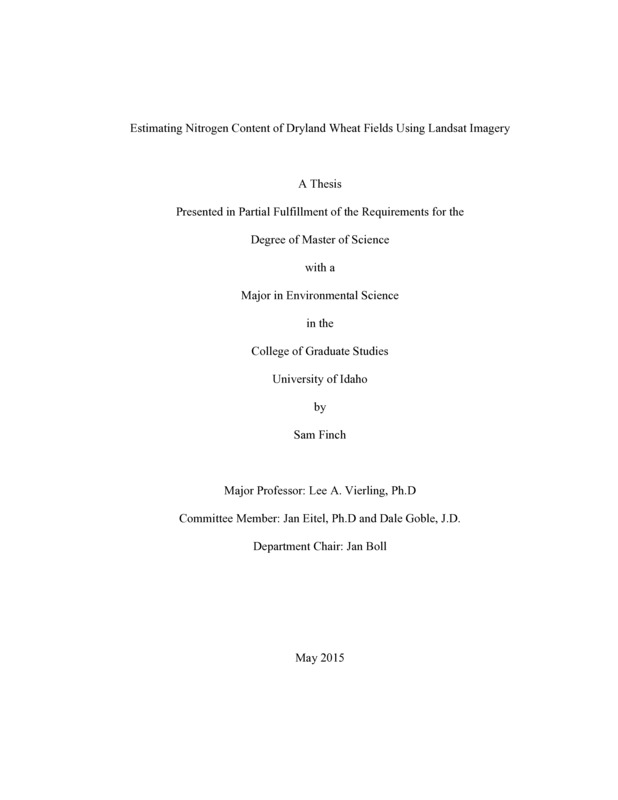Estimating Nitrogen Content of Dryland Wheat Fields Using Landsat Imagery
Finch, Sam Louis. (2015). Estimating Nitrogen Content of Dryland Wheat Fields Using Landsat Imagery. Theses and Dissertations Collection, University of Idaho Library Digital Collections. https://www.lib.uidaho.edu/digital/etd/items/finch_idaho_0089n_10593.html
- Title:
- Estimating Nitrogen Content of Dryland Wheat Fields Using Landsat Imagery
- Author:
- Finch, Sam Louis
- Date:
- 2015
- Embargo Remove Date:
- 2017-05-18
- Keywords:
- Landsat N content NDVI Nitrogen nitrogen fertilizer Remote Sensing
- Program:
- Environmental Science
- Subject Category:
- Remote sensing; Environmental science; Agronomy
- Abstract:
-
Inefficient use of synthetic nitrogen fertilizers on wheat fields increases costs of production and can cause numerous undesirable environmental consequences. Specifically, increasing plant nitrogen use efficiency may decrease agricultural sources of nitrous oxide, nitrate leaching, and soil acidification, while maintaining crop yield and quality. A main cause of inefficient nitrogen fertilizer application in industrial agricultural systems is a dearth of information about in-field nitrogen variability in crops. The objective of this study was to determine whether free, publicly available Landsat imagery could be used to predict N content in wheat plants across a spatially heterogeneous landscape. We derived field-scale N content by extrapolating plot-level destructive samples using commercially available Rapid Eye satellite data over five farms located in the Palouse of eastern Washington and northern Idaho, USA, in 2012 and 2013. We then used these results to compare with Landsat-derived Normalized Difference Vegetation Index to predict N content and map spatial variability at peak biomass. Statistical analyses of modeled versus observed N content show that Landsat-derived NDVI can predict N content of wheat crops to within 13 to 28 kg/ha of the N content map predicted using calibrated RapidEye data. We found statistically significant relationships between predicted N content and NDVI, with R2 values ranging between 0.20 to 0.82 depending on the field site.
NDVI may be inferior in estimating crop N content relative to other vegetation indices (e.g. the normalized difference red-edge index) not calculable using Landsat data. However, because Landsat NDVI could be used to describe significant amounts of variation in crop N content, these data are likely to be useful for improving N fertilizer management (e.g. through establishing fertilizer zones) at the field scale. When considered in conjunction with Landsat data being publicly available and globally relevant, Landsat-derived NDVI could be a useful and cost-effective tool for improving N management of wheat crops worldwide.
- Description:
- masters, M.S., Environmental Science -- University of Idaho - College of Graduate Studies, 2015
- Major Professor:
- Vierling, Lee A
- Committee:
- Eitel, Jan U.H.; Goble, Dale
- Defense Date:
- 2015
- Identifier:
- Finch_idaho_0089N_10593
- Type:
- Text
- Format Original:
- Format:
- application/pdf
- Rights:
- In Copyright - Educational Use Permitted. For more information, please contact University of Idaho Library Special Collections and Archives Department at libspec@uidaho.edu.
- Standardized Rights:
- http://rightsstatements.org/vocab/InC-EDU/1.0/

